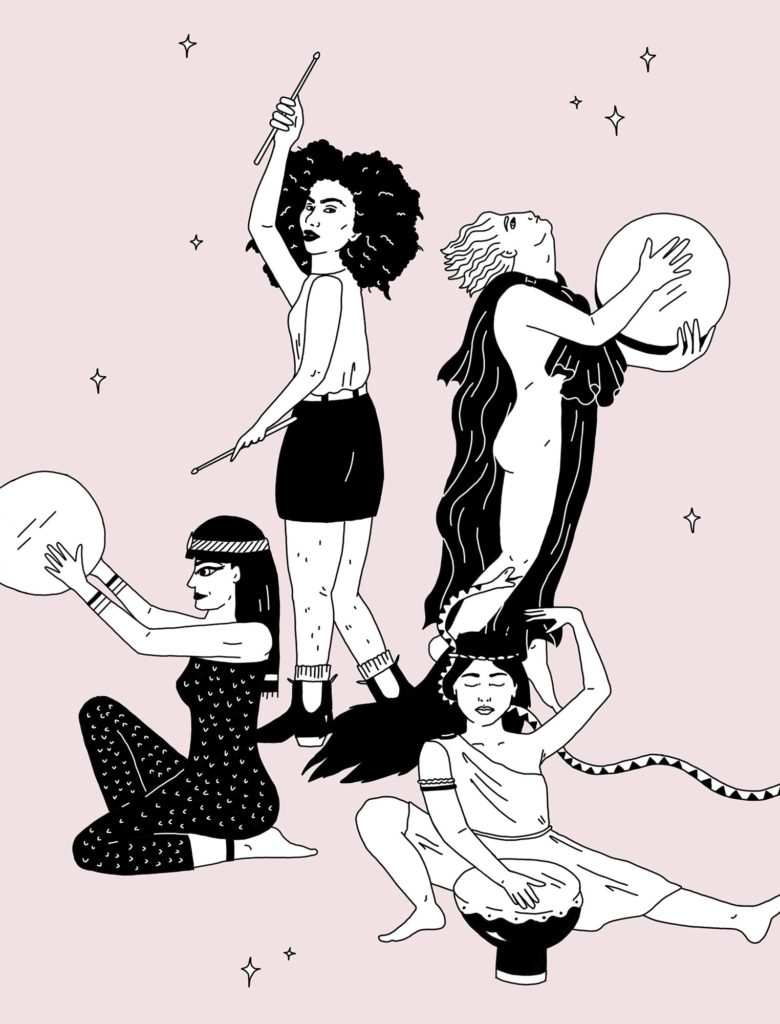Words by Angela Sells
Illustrations by Chloe McAlister
“I do believe that you only have one life. You have to stay true to your convictions, but it’s not going to be an easy road.”
Remember when all of the drummers were women? For centuries, the drums were viewed as a woman’s instrument, but outside of oral tradition, where is the comprehensive herstory of drumming or of women’s contributions to the realm of music? Specifically, where is the “Bible” showing women’s contributions to rock ’n’ roll?
I contacted Canadian music journalist Laina Dawes to speak about her book What Are You Doing Here? A Black Woman’s Life and Liberation in Heavy Metal, which explores Black women’s stories of participation in punk and metal and their experiences of being “othered” in scenes perceived as so-called “men’s spaces.”
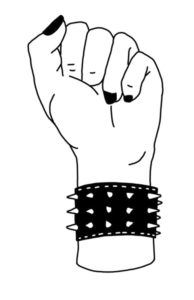 As a background to the topic and my conversation with Dawes, I looked into which pen-and-ink resources were available on this topic. Aside from Angela Smith’s valuable reference book Women Drummers: A History from Rock and Jazz to Blues and Country, nothing seems to have surpassed Layne Redmond’s research in When the Drummers Were Women. It is an incredible study of women percussionists of antiquity and modernity; she covers thousands of years. However, the book retails at $60 used and over $100 new online, which hardly makes the information readily accessible to the public. [Update: the book will be reissued this year at an affordable price in paperback!] In her book, Redmond explores the copious images and evidence that suggest drums were first associated with fertility. The beat of the drum mimicked the first beat we hear as humans—the heartbeat—within the womb. “With one stroke of the drum, everything comes into existence,” she notes. Women held the drum—and were keepers of it—as a sacred tool in cultures around the world, often used in religious ceremony. A Google search for female drummers might return priestesses of the Egyptian goddess Hathor, engraved in stone, playing her drum in ancient Egypt, or the ancient Phrygian goddess Cybele [pictured] with her frame drum in a Second Century bronze statue. Various Greek vases from the Fifth Century B.C. would show Maenads—those revelers of wine and passion—brandishing drums high above their heads.
As a background to the topic and my conversation with Dawes, I looked into which pen-and-ink resources were available on this topic. Aside from Angela Smith’s valuable reference book Women Drummers: A History from Rock and Jazz to Blues and Country, nothing seems to have surpassed Layne Redmond’s research in When the Drummers Were Women. It is an incredible study of women percussionists of antiquity and modernity; she covers thousands of years. However, the book retails at $60 used and over $100 new online, which hardly makes the information readily accessible to the public. [Update: the book will be reissued this year at an affordable price in paperback!] In her book, Redmond explores the copious images and evidence that suggest drums were first associated with fertility. The beat of the drum mimicked the first beat we hear as humans—the heartbeat—within the womb. “With one stroke of the drum, everything comes into existence,” she notes. Women held the drum—and were keepers of it—as a sacred tool in cultures around the world, often used in religious ceremony. A Google search for female drummers might return priestesses of the Egyptian goddess Hathor, engraved in stone, playing her drum in ancient Egypt, or the ancient Phrygian goddess Cybele [pictured] with her frame drum in a Second Century bronze statue. Various Greek vases from the Fifth Century B.C. would show Maenads—those revelers of wine and passion—brandishing drums high above their heads.
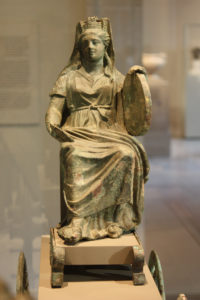
So, why is this not common knowledge? Why are drums considered a cis white man’s instrument?
Well, to be sweeping for a moment for the sake of brevity, with the rise of patriarchal power and monotheistic control in the past few centuries, ritual drumming—and especially, women drumming—was considered an act of heresy, an act thought to provoke lewd dancing and sexual deviancy. Women in their rhythmic expression were seen as “crazy.” One could be branded a witch. By the time composer Carl Ludwig Junker came around and created and distributed a “decorum for ladies” in 1784, women’s roles as audience rather than participants were clearly defined. He wrote, “The feeling of unsuitability which comes from the association of ideas between bodily movements and fashion of clothing. […] Ridiculous when we see her [playing] in a fancy hair-do.” That’s just one gem among many that restricted women from playing various instruments due to hair, clothing, or physical movements that might appear obscene. Of course, by the 1700s, women weren’t even supposed to play in the Phrygian mode, due to its “violent” and discordant tone that might incite “orgiastic” appetites.
What else happened that “othered” women and persons of color in drumming? Codes like the following, from South Carolina, were adhered to across the South during slavery: “It is absolutely necessary to the safety of this Province, that all due care be taken to restrain Negroes from using or keeping of drums, which may call together or give sign or notice to one another of their wicked designs and purposes.” For certain individuals, playing the drums elicited such an irrational fear of upsetting the status quo that they were—and continue to be in many parts of the world—suppressed, demonized, and controlled.
Still, why are women today often discouraged from music, and particularly from percussion? On average, only 16 percent of undergraduate and graduate percussion majors are women, better than the percentage of women percussion studies professors (6 percent). Even a smaller percentage than that actually garner widespread attention in the genres of rock ’n’ roll, punk, or metal. Music journalist Kristy Loye notes the latter’s violent aggression against women in the scene, “Many bands either openly encourage violence against women or fail to support legitimate female fandom, […] Female metal bands are rarely booked on national tours and practically ignored by the media.” In an account of last year’s 23 major US music festivals, only 11 percent of bands booked had at least one female member. Not surprisingly, an overwhelming number of those bands booked featured all-white members.
But remember when women and persons of color invented rock ’n’ roll?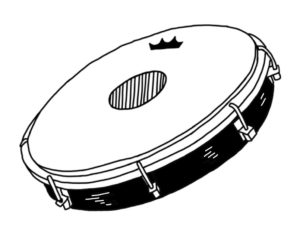
Remember back in 1967 when frontwoman Jinx Dawson of Coven—which included a band member named Oz Osbourne and a track titled “Black Sabbath” (yes, before the band Black Sabbath)—threw the horns up onstage in what music historians consider the first instance of that symbol being relayed to a rock audience? Remember when the Peruvian Los Saicos growled with anti-establishment attitude on 1964’s “Demolicion,” or when the all-Black band Death pioneered punk in 1973? No?
Though bands like Toscos and MilitiA represent non-conforming presences in the scene, and culturally, we do see a shift in representation, media at large has only recently begun to recognize such presences in festivals, on the radio, on TV, or in print. It was just a few months ago in 2018 that rhythm and blues artist Sister Rosetta Tharpe was inducted into the Rock and Roll Hall of Fame. Her revolutionary electric guitar picking style in her 1938 “Rock Me” influenced such giants as Little Richard, Jerry Lee Lewis, and Chuck Berry. During her tour in the U.K. with Muddy Waters in 1963, the likes of Eric Clapton and members of the Beatles were in the audience. Similarly, it was Big Mama Thornton’s—a gender-bending Black woman—single “Hound Dog” in 1953 that later made Elvis the King of Rock. Sadly, she never saw a penny in royalties from the now infamous recording by Elvis.
In a recent New Music article, Carrie Leigh Page and Dana Reason reported the ever-present mantra that’s haunted girls in bands since the 1940s: women playing well equates to women playing “just like men.” They wonder if such condescension results from a lack of support by media and record labels, lack of representation, or preconceived judgments about the worth of women’s work. One theory behind why women (womxn, womyn) and non-conforming drummers bear the brunt of backlash within harder rock scenes is that they are less “available” onstage. Encased in their own worlds behind a kit, they are not sexually accessible to an audience, seen as trespassing on “male territory” without offering their bodies up for consumption.
Of course, the above broad-strokes history is extremely complicated and requires a depth that exceeds this article. But with these issues in mind, let’s turn to Laina Dawes for an insider’s and expert’s opinion on an aspect of othering in hard music, perhaps the genre most associated with cis white men. But, it is also a space that has increased representation by non-white and nonbinary folks—not just as fans, but as performers, journalists, and active participants. And, as we will see, it is also a genre that grew out of specific contributions to music history made by women and people of color.
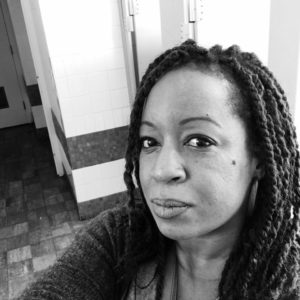 Your book [What Are You Doing Here? A Black Woman’s Life and Liberation in Heavy Metal] introduced me to many female artists I never had the luck of discovering on my own.
Your book [What Are You Doing Here? A Black Woman’s Life and Liberation in Heavy Metal] introduced me to many female artists I never had the luck of discovering on my own.
One of the things I wanted to do with the book is to introduce other female musicians. Here’s the problem: There are a lot of women of color out there who are really interested in the genre, not just as fans but also as journalists or musicians. They’re really hesitant to follow their passion, because they’re not seeing anyone that looks like them within the scene. They figure, “If there’s nobody out there, then I’m not going to do it. I don’t want to be the only person.” That’s one of the reasons it was really important to find other Black women artists [in the scene] out there.
And how did your participation in the scene come about? It seems that your love of metal was about peeling back the layers of race and exploring what you liked as an individual.
I grew up in a really weird environment, where my parents didn’t care [about the music playing]. As a Black person growing up in a predominantly white community, I knew that I would never fit into “white people,” but I also was rejected by Black people. I knew from a very early age that I would have to define myself as an individual, and I think that my gravitation to this music was very natural. I liked it, so I listened to it, and that was very simple.
Now, you’re seeing a lot of young women and women older than me [Laina was born in 1969] who are into these heavier genres of music. It is a very simple [internal] decision. The complicated part of it is the outside saying: “No, we don’t feel comfortable with you being an individual; you have to be a certain way, in order to make us feel comfortable.”
Something stood out in your book for me reclaiming metal as stemming from the structure of the blues. I thought that was really important.
Well, if you listen to early Black Sabbath, or watch early interviews from members of Black Sabbath, they will say, “We started off as a blues band. We were influenced by African-American blues.” A lot of the early bands, even to this day, if you listen to doom or sludge (like Eyehategod), it’s all blues music. You try to tell people that, and they don’t get it; they still see white faces performing the music.
To be fair, I have heard from a lot of people why there is that resistance; there is a sense of real fear. In the 1980s heavy metal scene, there were many white working men who called us [the N-word]. They tried to intimidate and beat us up. So, a lot of people extrapolate and think heavy metal is full of racism.
A lot of those stereotypes have been proven to deter people who like [for example] Pantera. They just don’t want to get beaten up, or be involved in a music culture where they are the minority.
Maybe it has to do with compartmentalization? It seems that, for me at least as a minority, we’ve frequently had to separate a band, a film, an actor—or what have you—from personal politics in order to continue appreciating the art. Do you think sometimes there’s an acceptance of behind the scenes racism from fans who just want to enjoy the music?
It depends on the individual. Personally, I don’t support artists who I know hold certain sentiments in terms of anti-Black racism, homophobia, misogyny, anti-immigrant, or anti-Semitism. Things that real people in the world have been murdered over, I will not support. . . . But that’s me. I have a very firm stand on that.
There are also people who say, “Oh, I know there’s this band that hates women or there’s a band that speaks about raping women, but it’s art.” There is a degree of freedom of expression allowed, because it might not affect them personally. It’s a very challenging situation, [. . .] which is why I ask the [following] question in the book as part of my survey: “What would you do if you found out that a band you really like or listen to told you that they are philosophically against what your views are?” Because I dealt with [that] as a listener and as a fan.
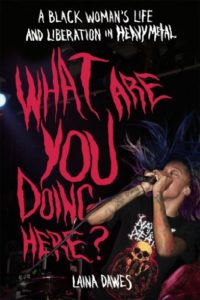 It’s complicated, for sure. When I was reading your book, so many women you reached out to were hesitant to “talk about racial and sexual politics in fear that their white colleagues would be turned off.” What is your advice for various genders and musicians of color now who are interested in rock, or who want to become a figure in the scene?
It’s complicated, for sure. When I was reading your book, so many women you reached out to were hesitant to “talk about racial and sexual politics in fear that their white colleagues would be turned off.” What is your advice for various genders and musicians of color now who are interested in rock, or who want to become a figure in the scene?
I would still say it’s important to speak out, but it’s a double-edged sword. I think it’s important to speak, because people have to understand that there are others listening and learning from you, so what you say has power. What you say can make someone think, it can make a difference, it can make a change. On the other hand, it can also turn people off of you. I know people who are very open in terms of speaking out against issues of racism and sexism within the heavy metal scene, and I also know that that has hindered them from certain opportunities.
But I do believe that you only have one life. You have to stay true to your convictions, but it’s not going to be an easy road. I think [certain artists] who didn’t want to speak to me are really in the media spotlight and have been monetarily successful. I can completely understand that. And we have to understand that their experience is real and valid, despite not wanting to “politicize” their presence within their scenes, their representation will still help a lot of people.
Now we’re talking about politics and its impact on commercial success.
I think that’s true. I’m writing [at the time] my thesis on extreme heavy metal cultures and a lot of the bands and the extreme metal record label industries are underground. It’s like that for a reason, and because of that, people are really passionate. So, when you start nitpicking at that community, the negative response you will get will be ten times harder than a response about another music genre.
There are metal and hardcore bands with Black musicians out there right now, such as Oceans of Slumber’s Cammie Gilbert, Bleed the Pig’s Foxxie Phillips, Tetararch’s Diamond Rowe, MilitiA, and Witch Mountain’s Kayla Dixon. In order to get these images out there, you have to be seeing videos, or more publicity about Black female musicians who are in bands. You’re not really seeing that, but I think it’s coming. These musicians are just rocking out, naturally doing what they want to do as individuals and not part of a prescribed image that Black women have to be in order to be in the public eye.
Which is also a double bind considering the stereotype of the angry Black woman trope, which severs many from the ability to be angry in public.
Right, and I think that is one of the issues. People don’t feel comfortable with angry people or angry music. But historically, in heavy metal, it’s always angry people playing angry music, because the music came out of this white, working class, socially and economically disenfranchised community. [. . .] There’s always been a societal allowance for people like Taylor Swift to be mad, because some guy dumps her; there’s never been an allowance for public Black anger.
It’s hard. One of the reasons why I’m interested in the resistance to Black representation within heavier genres of music is based on the false notion of why the music originated in the first place. [Also] it’s supposed to be inclusive, it’s supposed to be about the music. What you look like as a performer is not supposed to matter. Theoretically speaking, there is still more freedom for Black women’s self-expression within heavy music, versus any other genre of music within popular culture.
Speaking of “supposed to,” what you wrote about Bessie Smith and the time she challenged the KKK during one of her performances—even when calling them out could have led to personal attack—was amazing. She was truly revolutionary, so it’s then sad to consider that she came to define how Black women were “supposed to” look and sound onstage.
True. She was challenging the status quo. For Bessie Smith, what made that story interesting to me was what she did offstage. During that particular performance, to tell [the KKK] “Get out of here,” was something that could have put her life in danger, but she didn’t care.
If you look at Billie Holiday, her decision to cover the song “Strange Fruit” was a unique decision, because she talked about lynching and racism in an era [1939], in which it was difficult for Black women to publicly share their opinion.
Nina Simone is a really good example of what happens when you speak out. She was always an outspoken woman, and she suffered the repercussions of being political in America, where people came to say, “We love it when you sing about love, but we don’t love it when you speak about politics, civil rights, and Martin Luther King.” And she paid the price [commercially].
At some point, you have to break out of the prescribed “codes,” and do what you want to do.
You have to be perceived as an individual. It’s so easy to say that to you and for me to believe it, but I think we also have to assert it. But there might be a price to pay.
True metalheads do not care about the “other,” or your sexual preference, or your religion, or ethnicity. They care about having respect for the music and the culture. They care about having enough bodies to support the music’s evolution; they don’t care about what you look like.
Getting back to what music is supposed to do: transcend.
I believe it can and does, but the problem is that there is real threat of violence to cultural minorities. If we’re passionate about this genre, we have to look at the bad as well as the good, and we have to look at ways to make it better. I’ve had it said to me, “It’s just a few bad apples, so why make a big deal out of it?” For me, it’s the people who sit by the sidelines that through their silence are just as implicit in maintaining exclusionary practices that alienate people from participating. You have to acknowledge that sometimes the music brings out people who are angry for the wrong reasons and that is deterring the development of a culture that is heavily reliant on active participation.
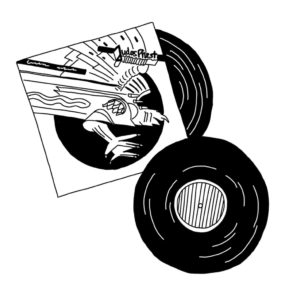 I also think that it’s dangerous to define prejudice through “extreme violence,” or that only “hostile” racism is toxic.
I also think that it’s dangerous to define prejudice through “extreme violence,” or that only “hostile” racism is toxic.
It is very dangerous, because it’s a gate to the insidiousness of how passive racism can really [mess] somebody up. I found that through the interviews [in the book] and the interviews I’ve done since then, it’s not about somebody throwing a beer bottle at your head. It’s the feeling or silent understanding that you do not belong, the passive-aggressive micro-aggressions that are more damaging than anything else.
For me, there’s nothing worse than going to a show and feeling a level of hostility that’s always there, which makes people not want to participate.
I think that also as Black women, we need something to balance the internalized negativity that is developed through how the outside world perceives us. The women that I interviewed found that heavy music serves that for them. That in itself, regardless of going to a show or finding friends, but just listening to angry music, is the only way a lot of us can justifiably feel anger and let that anger go. That’s the main key.
Well, that’s a perfect note to end on. Just one more light question. What is the album that led you to self-proclaim as a metalhead?
Judas Priest, Screaming for Vengeance, especially the title track. At 11 years old, it was probably the heaviest, loudest, most aggressive track I’d ever heard. It made my heart race, made goose bumps on my arms. I became a massive Judas Priest fan, and it made me search for heavier, and heavier, and heavier music.
Follow Laina Dawes: Instagram//Buy Her Book//Facebook//Twitter
This article can be found in Issue 36 of Tom Tom: Buy it Here.
Watch the late Layne Redmond speak about the ancient roots of women and drumming below:


